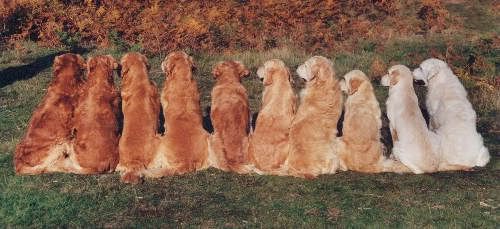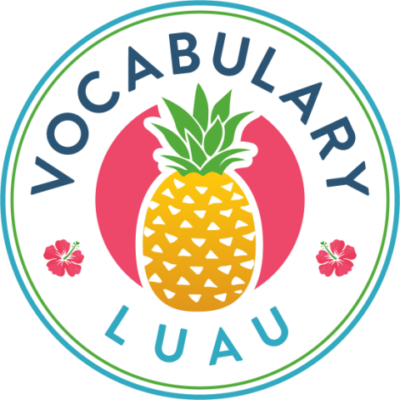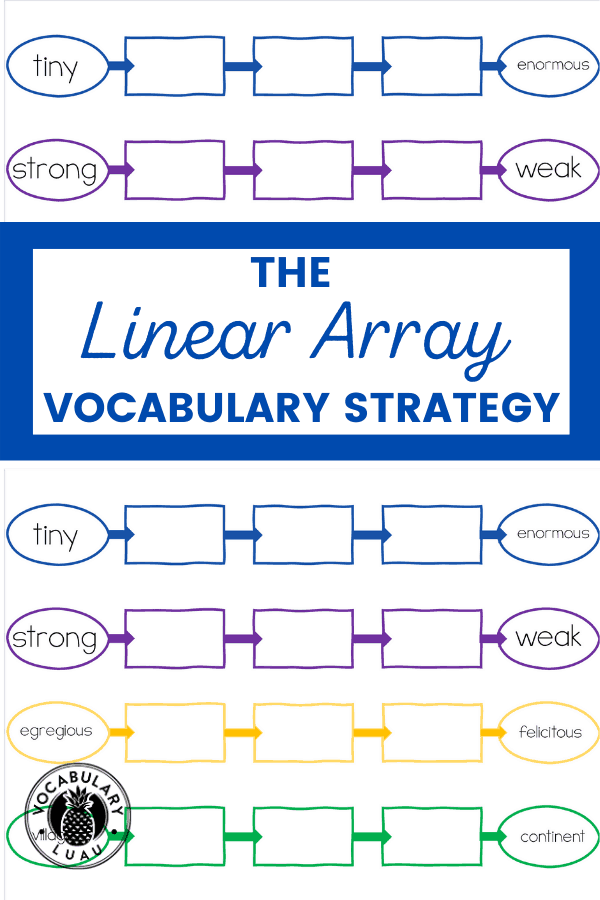“Linear Array” sounds super mathy, doesn’t it?
In this strategy, students use a graphic organizer that is a rectangle, three ovals, and then another rectangle, all in a line.
Students are given five words to fill in the shapes. Words that are opposites are placed in the rectangles.
The students move from rectangle to rectangle, filling in the ovals with progressive words that lead from one word to its opposite.
Sound intriguing? Let’s look at how it’s done.
? How Does the Linear Array Strategy Work Exactly?
Place a word in the rectangle on the left. On the far right, put in a word that is the opposite of that word.
For example, hot and cold, joy and despair, or democracy and dictatorship.
Students then fill in the ovals between those rectangles with words that move the student from the meaning of the word in one rectangle to the other.
The words in each oval become progressively less similar than the word in the left rectangle. It works best with words from literature, rather than informational text, although I’ve used it both ways.
Here are a couple of examples:


This strategy was described in the book Words, Words, Words: Teaching Vocabulary in Grades 4 – 12 by Janet Allen.
Note: I’m a big believer in independent bookstores, and this is an affiliate link to IndieBound, where you can support independent booksellers. There is no extra cost to you.
? How to Introduce the Linear Array Strategy to Students
I show this picture of Golden Retrievers of different colors:

I have an English Cream Golden Retriever (the white kind), so my students can relate to this photo because they’re used to my dog, Brody.
Oh, okay, I’ll show you a picture of my dog (since you insist).

Note: You can use a different photo of anything that moves from one gradation of color to another.
However, I would not use an image of different shades of just a color (like green) because you may have students who are color blind and will miss the entire idea.
I write red on the left side of the board or screen, and I write white on the right side.
I then draw rectangles around those words and draw three ovals in between them.
I explain that these Golden Retrievers are arrayed or lined up from dark red to white.
If they don’t know the word array, I explain that an array is when we line things ups or organize things in rows and columns.
I ask them to choose three colors that will describe how these dogs move from red to white. What colors do we see in between these two ends?
They give me a few suggestions, and I fill in the ovals, making sure it makes sense.
I love the color words they come up with (butterscotch, for example).
I explain that words have shades of meaning, just like the dogs have shades of their coats. Some words are very similar to each other, just like the two dogs on the left have very similarly colored coats.
Some words are the opposite of each other, like the white and red dog. If students know the word antonym, I use that.
I explain that we’re going to use an activity called a linear array to help us do with words what we just did with the dogs.
We’re going to start with opposites, and we’re going to fill in the gradations, or shades, of meaning. When we do this, we can look at the order words go in or the degree of meaning.
? Give Another Example
Next, I’ll write two more rectangles on the board with three ovals between.
In the rectangles, I’ll put whisper on the left and shout on the right.
I explain that these are different levels or degrees of speaking. We whisper the word whisper and shout the word shout. Yes, even my 10th graders!
Then, I ask for ideas of words that could go between these two, words that are other degrees of loudness of voice.
I put all of the words on the board or screen in a big brainstorm, and then we look at which one would best go next to whisper.
We move to the right, choosing two more words and saying the word in the tone we think it represents.
We then check ourselves in the order we have and decide if our suggestions are reasonable. Sometimes we do some switching out or around here.
I’m using a lot of words to explain this so you know exactly how it’s done, but this is about a ten-minute activity from start to finish. It can be longer if your students are chatty(!) or if you have the brainstorm last a long time.
?Have Them Practice in Groups
Next, I have them practice in groups. I give them the graphic organizer and have them practice with word groups I’ve prepared.
You can choose groups of words from your content, but if my students haven’t done this before, I usually pick common words to get them used to the activity.
When I give them their word groups, I remind them that some words will be organized by degree and some will placed in order.
?Possible Word Groups:
Give them the word groups are scrambled. I’m putting them in order for your use, but you wouldn’t give the words to them like this or you’ve done the activity!
- child, parent, grandparent, great-grandparent, great-great grandparent
- ugly, homely, attractive, pretty, gorgeous
- freezing, cold, lukewarm, warm, hot
- conversation, discussion, disagreement, argument, fight
- sad, contented, cheerful, happy, ecstatic
- unreliable, wobbly, stable, secure, sturdy
If you want to make up your own examples or have students do so, have them search for synonyms and antonyms of a word and put those in order of degree.
If you do that, make sure you keep the connotation constant. For example, loyal is an antonym of unreliable, but it’s a different connotation than the example we’re using here.
After giving them a few minutes to order their words, I have them share out as groups. I then explain that we’ll be using the linear array strategy to analyze words in class.
After this introduction, students are ready to do the activity, and you can use it for vocabulary words you’re encountering in text.
Keep reading for more ideas and variations!
? Do You Have to Use a Graphic Organizer?
Nope. However, I strongly recommend that you do. The graphic organizer:
- Allows students to see clearly the progression from one word to the other
- Keeps the work visually appealing
- Makes it easy to tell when the assignment is complete (no missing a word!)
- Makes it easier for the teacher to evaluate
That said, you don’t have to use it if you don’t want to.
? Variations on the Linear Array Strategy
The basic strategy is that the teacher gives the students all five words.
To vary this:
- Give only the words that would go in the rectangles and have students come up with appropriate words for the ovals.
- Try the reverse, giving students the words that go in the ovals and have them come up with the “bookend” words that go in the rectangles.
- For extra complexity, give small groups a big set of words, perhaps twenty-five, and have them sort them into word families and then array them.
- Share an array with an error (lazy, energetic, conscientious, bored, assiduous). In this case, bored is out of place.
- Have students each represent the word. Holding up word strips, they array themselves as a group. The rest of the class gives a thumbs up when they’re correct.
I think you can see the flexibility of this activity!
? What Are the Benefits of the Linear Array Vocabulary Strategy?
In addition to being a great strategy in our word exposure arsenal, linear arrays have other more specific benefits.
Because linear arrays ask students to analyze the gradation between words, they ask for a subtle level of analysis that can be difficult to find in many activities.
When students can do this well, they make connections between words more easily. They will also become more adept at noticing subtle differences in word meaning and connotation.
It’s a strategy that works equally well with elementary and secondary students, which makes it quite flexible.
? Wrapping Up:
I hope you’re encouraged to give the linear array strategy a shot.
While it isn’t perfect for every vocabulary word, when it’s a good fit, it’s terrific.
If you have the graphic organizer, it’s very low prep as well (especially if you ask students to come up with their own “oval” words).


